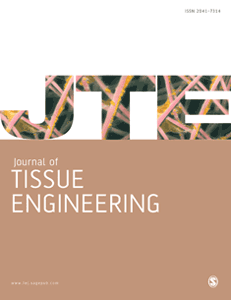用于修复下颌骨节段性缺损的生物工程软骨移植物
IF 7
1区 工程技术
Q1 CELL & TISSUE ENGINEERING
引用次数: 0
摘要
重建临界大小的颅面骨缺损是一项全球性的医疗挑战。目前的方法,如自体骨移植,面临着局限性。骨组织工程提供了一种替代自体骨的方法,传统方法侧重于通过膜内骨化(IMO)途径刺激成骨。然而,膜内骨化途径无法解决较大的缺损问题,尤其是在血管化不足的临床情况下。本综述探讨了通过软骨内骨化(ECO)重新引导骨再生,这是缺氧条件下刺激长骨愈合时观察到的一个过程。尽管ECO前景广阔,但在将其应用于骨组织工程实验方面仍存在差距,需要阐明细胞来源、生物材料和预处理方案等关键方面。本综述讨论了用于软骨生成和肥大软骨细胞诱导的各种支架生物材料和细胞来源,反映了 ECO 途径。综述强调了目前软骨内引物所面临的挑战,并提出了替代方法。重点是下颌骨节段性缺损修复,为未来研究和临床应用提供启示。这篇简明扼要的综述旨在通过解决 ECO 策略中的关键差距来推动骨组织工程学的发展。本文章由计算机程序翻译,如有差异,请以英文原文为准。
Bioengineered cartilaginous grafts for repairing segmental mandibular defects
Reconstructing critical-sized craniofacial bone defects is a global healthcare challenge. Current methods, like autologous bone transplantation, face limitations. Bone tissue engineering offers an alternative to autologous bone, with traditional approaches focusing on stimulating osteogenesis via the intramembranous ossification (IMO) pathway. However, IMO falls short in addressing larger defects, particularly in clinical scenarios where there is insufficient vascularisation. This review explores redirecting bone regeneration through endochondral ossification (ECO), a process observed in long bone healing stimulated by hypoxic conditions. Despite its promise, gaps exist in applying ECO to bone tissue engineering experiments, requiring the elucidation of key aspects such as cell sources, biomaterials and priming protocols. This review discusses various scaffold biomaterials and cellular sources for chondrogenesis and hypertrophic chondrocyte priming, mirroring the ECO pathway. The review highlights challenges in current endochondral priming and proposes alternative approaches. Emphasis is on segmental mandibular defect repair, offering insights for future research and clinical application. This concise review aims to advance bone tissue engineering by addressing critical gaps in ECO strategies.
求助全文
通过发布文献求助,成功后即可免费获取论文全文。
去求助
来源期刊

Journal of Tissue Engineering
Engineering-Biomedical Engineering
CiteScore
11.60
自引率
4.90%
发文量
52
审稿时长
12 weeks
期刊介绍:
The Journal of Tissue Engineering (JTE) is a peer-reviewed, open-access journal dedicated to scientific research in the field of tissue engineering and its clinical applications. Our journal encompasses a wide range of interests, from the fundamental aspects of stem cells and progenitor cells, including their expansion to viable numbers, to an in-depth understanding of their differentiation processes. Join us in exploring the latest advancements in tissue engineering and its clinical translation.
 求助内容:
求助内容: 应助结果提醒方式:
应助结果提醒方式:


